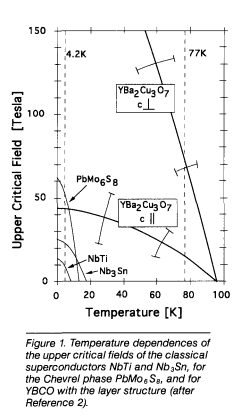Article contents
Materials Engineering Problems in Crystal Growth and Epitaxy of Cuprate Superconductors
Published online by Cambridge University Press: 29 November 2013
Extract
The discovery of superconductivity in yttrium barium cuprate above the boiling point of liquid nitrogen by Wu et al. initiated a race in the search for higher critical temperatures (Tc) which was singular in the history of science. Since the ceramic superconducting pellets could be prepared nearly overnight and superconductivity easily demonstrated with liquid nitrogen and a levitating magnet, a great deal of effort went into garnering funds for a “new technological era.” High Tc superconductivity (HTSC) was expected to have applications in many areas of our life, be it for energy transport and high-power generators, transformers, current limiters, or for ultrafast computers and communication technology, or in medicine for NMR tomography and for SQUIDs in magnetic encephalography. Large-scale uses were also foreseen, such as levitation for trains, magnetohydrodynamic propulsion in ships, and applications for fusion reactors. Thousands of physicists and engineers searched for new materials with high Tc, and explored thin-film preparation by physical vapor deposition. In the early phase only a few scientists recognized that materials engineering problems would greatly hinder the development of applications of the cuprate superconductors. Most early efforts on HTSC went toward physical investigations of samples (crystals, layers, sheets, wires, etc.) which due to their complexity could not be reproducibly prepared, and which were not adequately characterized (see the section on Characterization). The Bi-, Tl-, and Hg-containing cuprates with Tc up to 135 K, for example, were found empirically, not by physical understanding of the HTSC phenomenon. Applications of HTSC have been limited to very specific areas, but a concerted effort should reveal opportunities for the materials research and superconductivity communities. Significant applications could be developed

which in the long run would also benefit fundamental physical investigations of the HTSC phenomenon.
- Type
- Crystal Engineering of High Tc-Related Oxide Films
- Information
- Copyright
- Copyright © Materials Research Society 1994
References
- 38
- Cited by




